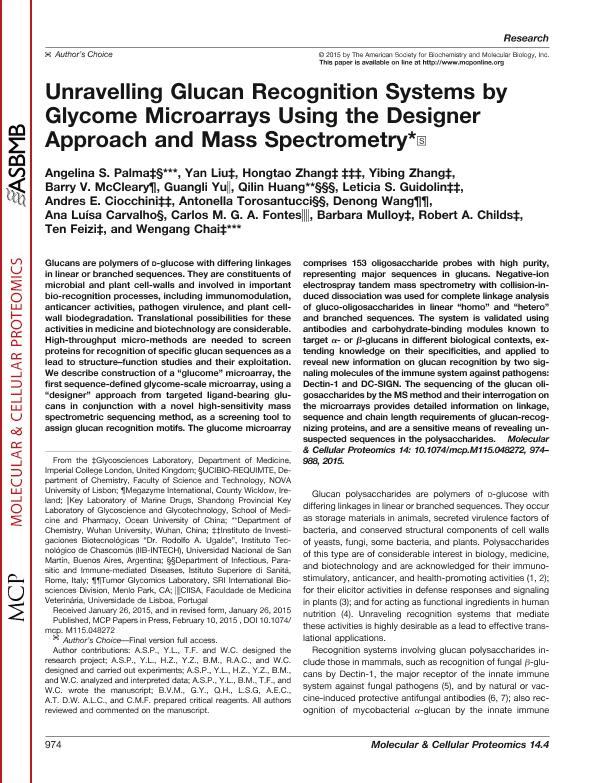Mostrar el registro sencillo del ítem
dc.contributor.author
Palma, Angelina S.
dc.contributor.author
Liu, Yan
dc.contributor.author
Zhang, Hongtao
dc.contributor.author
Zhang, Yibing
dc.contributor.author
McCleary, Barry V.
dc.contributor.author
Yu, Guangli
dc.contributor.author
Huang, Qilin
dc.contributor.author
Guidolin, Leticia Soledad

dc.contributor.author
Ciocchini, Andres Eduardo

dc.contributor.author
Torosantucci, Antonella
dc.contributor.author
Wang, Denong
dc.contributor.author
Carvalho, Ana Luísa
dc.contributor.author
Fontes, Carlos M. G. A.
dc.contributor.author
Mulloy, Barbara
dc.contributor.author
Childs, Robert A.
dc.contributor.author
Feizi, Ten
dc.contributor.author
Chai, Wengang
dc.date.available
2018-03-13T19:20:27Z
dc.date.issued
2015-04
dc.identifier.citation
Palma, Angelina S.; Liu, Yan; Zhang, Hongtao; Zhang, Yibing; McCleary, Barry V.; et al.; Unravelling glucan recognition systems by glycome microarrays using the designer approach and mass spectrometry; American Society for Biochemistry and Molecular Biology; Molecular & Cellular Proteomics; 14; 4; 4-2015; 974-988
dc.identifier.issn
1535-9476
dc.identifier.uri
http://hdl.handle.net/11336/38692
dc.description.abstract
Glucans are polymers of D-glucose with differing linkages in linear or branched sequences. They are constituents of microbial and plant cell-walls and involved in important bio-recognition processes, including immunomodulation, anticancer activities, pathogen virulence, and plant cellwall biodegradation. Translational possibilities for these activities in medicine and biotechnology are considerable. High-throughput micro-methods are needed to screen proteins for recognition of specific glucan sequences as a lead to structure-function studies and their exploitation. We describe construction of a "glucome" microarray, the first sequence-defined glycome-scale microarray, using a "designer" approach from targeted ligand-bearing glucans in conjunction with a novel high-sensitivity mass spectrometric sequencing method, as a screening tool to assign glucan recognition motifs. The glucome microarray comprises 153 oligosaccharide probes with high purity, representing major sequences in glucans. Negative-ion electrospray tandem mass spectrometry with collision-induced dissociation was used for complete linkage analysis of gluco-oligosaccharides in linear "homo" and "hetero" and branched sequences. The system is validated using antibodies and carbohydrate-binding modules known to target α- or β-glucans in different biological contexts, extending knowledge on their specificities, and applied to reveal new information on glucan recognition by two signaling molecules of the immune system against pathogens: Dectin-1 and DC-SIGN. The sequencing of the glucan oligosaccharides by the MS method and their interrogation on the microarrays provides detailed information on linkage, sequence and chain length requirements of glucan-recognizing proteins, and are a sensitive means of revealing unsuspected sequences in the polysaccharides.
dc.format
application/pdf
dc.language.iso
eng
dc.publisher
American Society for Biochemistry and Molecular Biology

dc.rights
info:eu-repo/semantics/openAccess
dc.rights.uri
https://creativecommons.org/licenses/by-nc-nd/2.5/ar/
dc.subject
Glucan
dc.subject
Glucan Recognition Motifs
dc.subject
Oligosaccharides
dc.subject
Microarray
dc.subject
Mass Spectrometry
dc.subject
Glycome
dc.subject
Glucome
dc.subject.classification
Otras Ciencias Biológicas

dc.subject.classification
Ciencias Biológicas

dc.subject.classification
CIENCIAS NATURALES Y EXACTAS

dc.title
Unravelling glucan recognition systems by glycome microarrays using the designer approach and mass spectrometry
dc.type
info:eu-repo/semantics/article
dc.type
info:ar-repo/semantics/artículo
dc.type
info:eu-repo/semantics/publishedVersion
dc.date.updated
2018-03-06T17:43:17Z
dc.journal.volume
14
dc.journal.number
4
dc.journal.pagination
974-988
dc.journal.pais
Estados Unidos

dc.journal.ciudad
Bethesda
dc.description.fil
Fil: Palma, Angelina S.. Imperial College London; Reino Unido. Universidade de Lisboa; Portugal
dc.description.fil
Fil: Liu, Yan. Imperial College London; Reino Unido
dc.description.fil
Fil: Zhang, Hongtao. Imperial College London; Reino Unido. Jiangnan University; China
dc.description.fil
Fil: Zhang, Yibing. Imperial College London; Reino Unido
dc.description.fil
Fil: McCleary, Barry V.. Megazyme International Ireland; Irlanda
dc.description.fil
Fil: Yu, Guangli. Ocean University Of China; China
dc.description.fil
Fil: Huang, Qilin. Huazhong Agricultural University; China. Wuhan University; China
dc.description.fil
Fil: Guidolin, Leticia Soledad. Consejo Nacional de Investigaciones Científicas y Técnicas. Centro Científico Tecnológico Conicet - La Plata. Instituto de Investigaciones Biotecnológicas. Instituto de Investigaciones Biotecnológicas "Dr. Raúl Alfonsín" (sede Chascomús). Universidad Nacional de San Martín. Instituto de Investigaciones Biotecnológicas. Instituto de Investigaciones Biotecnológicas "Dr. Raúl Alfonsín" (sede Chascomús); Argentina
dc.description.fil
Fil: Ciocchini, Andres Eduardo. Consejo Nacional de Investigaciones Científicas y Técnicas. Centro Científico Tecnológico Conicet - La Plata. Instituto de Investigaciones Biotecnológicas. Instituto de Investigaciones Biotecnológicas "Dr. Raúl Alfonsín" (sede Chascomús). Universidad Nacional de San Martín. Instituto de Investigaciones Biotecnológicas. Instituto de Investigaciones Biotecnológicas "Dr. Raúl Alfonsín" (sede Chascomús); Argentina
dc.description.fil
Fil: Torosantucci, Antonella. Istituto Superiore Di Sanita; Italia
dc.description.fil
Fil: Wang, Denong. Sri International; Estados Unidos
dc.description.fil
Fil: Carvalho, Ana Luísa. Universidade de Lisboa; Portugal
dc.description.fil
Fil: Fontes, Carlos M. G. A.. Universidade de Lisboa; Portugal
dc.description.fil
Fil: Mulloy, Barbara. Imperial College London; Reino Unido
dc.description.fil
Fil: Childs, Robert A.. Imperial College London; Reino Unido
dc.description.fil
Fil: Feizi, Ten. Imperial College London; Reino Unido
dc.description.fil
Fil: Chai, Wengang. Imperial College London; Reino Unido
dc.journal.title
Molecular & Cellular Proteomics

dc.relation.alternativeid
info:eu-repo/semantics/altIdentifier/doi/http://dx.doi.org/10.1074/mcp.M115.048272
dc.relation.alternativeid
info:eu-repo/semantics/altIdentifier/url/http://www.mcponline.org/content/14/4/974.long
dc.relation.alternativeid
info:eu-repo/semantics/altIdentifier/url/https://www.ncbi.nlm.nih.gov/pmc/articles/PMC4390274/
Archivos asociados
